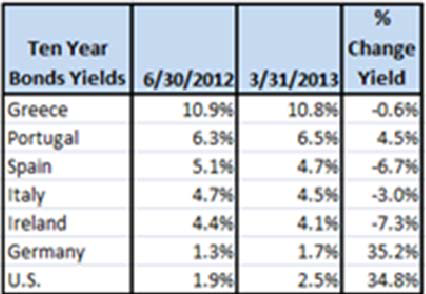Year to date the Covestor 50+ portfolio has returned 22.3% vs. the S&P 500’s 27.5% through December 11. It has been a very strong year so far, but we should not become complacent.
Let’s face it, while we can enjoy the last few years of stellar returns, we can’t count on these kind of returns going forward. I am therefore even more satisfied that the 50+ portfolio continues to achieve an overall return exceeding 8%.
Historically, dividends have represented over 50% of the total market return. Another study shows that not only did returns increase with dividend yields, but that the highest risk-adjusted returns came from high 10-17% dividend payers.
Despite a great couple of years, we therefore continue to focus on finding the most appealing income paying assets. We think these assets have five main advantages:
1) The need to pay a dividend imposes discipline on company management. CEOs fall in love with their own growth projects. The need to fund regular payments to shareholders requires them to choose from among them.
In the case of MLP’s (master limited partnerships), REIT’s (real estate investment trusts) and BDC’s (business development companies) this requirement is even stricter. Since they have to pay out 90% of taxable earnings to shareholders, they frequently have to go back to investors or banks and ask for more funding in order to fund large projects and purchases.
2) Dividends and distributions can potentially provide support in downturns. When the market drops 50%, people tend to hold on to equities which are still paying them a regular income. The non-yielder gets dumped quickly, but they think twice before dumping the income producer. If the dividend can be maintained, the increasing yields created by price declines also serve to attract new investors.
3) Dividends when re-invested are countercyclical. Buy low and sell high is the old mantra, but it’s hard to do. Re-invested dividends naturally produce this effect as you are able to buy more shares when the price is low than when it is high. This is also one reason why dividend payers tend to recoup losses from bear markets more quickly. Devoted re-investors are buying right through the downturn and into the next upturn.
4) Baby boomers will continue to provide demand for income producing assets. Baby boomers will be retiring in ever greater number over the next few decades. At this stage in life one moves from accumulation to distribution of assets. The natural tendency therefore is to emphasize income producing assets. No one wants to run out of money before they run out of life.
5) In my opinion, dividends currently provide more income than bonds. In addition, dividend payments can sometimes grow with inflation; most bond payments usually don’t in my view.
In November, we bought NTELOS Holdings (NTLS). This stock first showed up in our favorite dividend growth screen. It is a regional telecom providing wireless communications in Virginia and West Virginia.
It has been able to increase subscriber growth for the last seven quarters with revenues increasing over 14% last quarter vs the same quarter the year before. The company also recently concluded a favorable settlement with Sprint (S) which should clear the way for continued moderate growth. NTLS supports a yield of 8.1%.
At the same time, we sold KCAP Financial (KCAP).
KCAP is also a company which first showed up on one of our screens back in January. It is a business development company (BDC).
BDCs typically take money at today’s low rates and attempt to put it to work by making loans to middle market companies. In return the BDC receives an interest rate which is significantly higher than its costs plus frequently some warrants or other equity kicker.
It’s kind of a cross between a bank and a venture capitalist firm. This is a generally a good business to be in when rates are low and stock markets are increasing in value. We continue to own other names in the sector.
However, KCAP has not worked out as planned. In August the stock plummeted when the second quarter earnings report and outlook came out significantly below expectations. Since then we have not seen significant improvement and feel there may be further risk of non-performing loans hitting net asset value and income.
While KCAP has a trailing dividend yield of 12.2% as of this writing, we decided to close the position for a 13% loss net of dividends received. This will serve to both fund other positions which we feel have better outlooks, and to harvest tax losses prior to the end of the year.
We bought the preferred shares of Commonwealth REIT (CWH-PD) & Miller Energy (MILL-PD). The underlying REIT, Commonwealth, is undergoing a battle for control with activist investors which could result in a fundamental change in the board of directors.
The prospectus of CWH-PD indicates, “Upon a fundamental change, you may require us to convert some or all of your Series D Preferred Shares at a conversion rate equal to the liquidation preference of the Series D Preferred Shares….” The liquidation preference is $25 per share; which is a potential gain of 18% from today’s closing price. In the meantime, we get to collect the 7.7% yield while we wait.
MILL-PD, unlike the underlying common stock, appears to be underfollowed and misquoted. Miller Energy is an oil and gas exploration and production company with assets in Alaska and the Appalachian region.
Its common stock has doubled in the last year and a half; however, there is also a lot of investors who think that price has gone too far too fast. Short interest is over 20%. Analyst earnings estimates have been rising recently; wells that were flooded are producing again, and overall sales have doubled in the last year. Who will ultimately be proven correct? I don’t know.
What we as investors in the preferred are mainly concerned with is that Miller Energy just continues to be an ongoing concern paying us our 11% yield (based on the current price on preferred of about $24). That yield is misquoted as 7.7% on many of the popular investing sites.
Maybe that has resulted in these preferred shares being misunderstood and underfollowed? It could also be misunderstood because it is an uncommon fixed to floating issue. MILL-PD converts to a floating rate issue at LIBOR + 9.03% in 2018 if not redeemed.
I find this a benefit as it provides some inflation protection should rates rise, but others may find it confusing.
I bought CVR Refining (CVRR) & Northern Tier Energy LP (NTI). The fracking revolution has been, and will likely continue to be, a central theme around many 50+ portfolio investments.
Everyone has heard of fracking, and many people realize that fracking isn’t the result of a discovery of new deposits but instead is due to a new technology. However, not everyone realizes what that implies. The technological improvement hasn’t stopped, it is continuing to be developed and improved.
This in return is leading to the ability to economically access new reserves and pump more out of those reserves. In other words, we’re not just drilling more wells in places we couldn’t before, we are also getting more out of each well and getting it out at a higher flow rate.
As the technology improves, production growth may therefore continue to be more exponential rather than linear. Meanwhile, infrastructure just hasn’t been able to keep up. Both CVR and Northern Tier are oil refineries (NTI also owns a 230 Super America convenience stores) which take advantage of this lack of infrastructure.
Because oil transportation infrastructure is behind the curve and current laws don’t let us export crude oil, prices in different parts of the country are cheaper than the prevailing worldwide rate. CVRR and NTI earn a spread from turning crude oil into usable products like gas and propane, but they also effectively earn a significant spread between the cost of crude oil at their location and the worldwide cost.
I have no way of knowing for sure, but I believe this spread is going to continue longer than expected. NTI and CVRR yield and stock prices recently dropped due to plant turnarounds and RIN (renewable energy credits) costs depressing Q3 earnings.
We are taking advantage of that to buy some shares. Improvement in these factors and improvement in the spread should lead to higher dividends. Risks include that NTI and CVRR are both variable dividend payers, ranging anywhere from 5% to 20%+ over the last year.
Since they don’t try to smooth out dividend payments but instead pay based on earnings each quarter, the dividend could be 0 in any given quarter. There are only three refineries between them, so when things go wrong in any one, the dividend payment and the stock price will suffer.
Also one should be aware that NTI and CVRR are limited partnerships. The investor will need to fill out a K-1 for each in their annual taxes. I find the K-1 a small nuisance in return for tax deferred treatment of the dividends and expect both NTI and CVRR to produce dividends averaging in the low teens for the next few years.
I also added bought Capital Product Partners LP (CPLP) to the portfolio. CPLP is a shipping company. The company owns ships that transport refined oil products (clean tankers), crude (dirty tankers) and most recently shipping containers (containerships).
It then leases these ships to other companies such as Exxon (XOM) or Hyundai for transport of their goods. It was the clean tankers which originally attracted me to this company.
However, it is not illegal to export the diesel and other products refined from this crude. CPLP’s clean tankers therefore supply an outlet valve for America’s refined oil products. For this reason, the spread between prices in America’s heartland and worldwide prices (as represented by the WTI/Brent spread) influences the demand of shipping refined products out of America to other ports.
Until recently, high renewable energy credits (REN) prices also supported demand. Refiners don’t have to buy RENs for products they exported, so when energy credit prices are high, they tend to export more. However, the government has recently relaxed REN requirements which reduced this driver and CPLP’s stock price.
I think despite this challenge, CPLP can continue to pay and eventually increase their dividend. The recent three containership purchase came along with long term leases from Hyundai at reasonable prices. Essentially, I think Hyundai’s need to raise some cash resulted in a good deal for Capital.
Additionally, the WTI / Brent spread has been increasing, which hopefully will support lease rates on the clean product tankers despite lower REN prices. Last, we have recently seen an improvement in crude tanker lease rates. CPLP has a 10% tax deferred yield.
Here’s hoping the remainder of 2013 treats us as well as the year has so far.
DISCLAIMER: The investments discussed are held in client accounts as of November 30, 2013. These investments may or may not be currently held in client accounts. The reader should not assume that any investments identified were or will be profitable or that any investment recommendations or investment decisions we make in the future will be profitable. Dividends reflect past performance and there is no guarantee they will continue to be paid. Past performance is no guarantee of future results.




